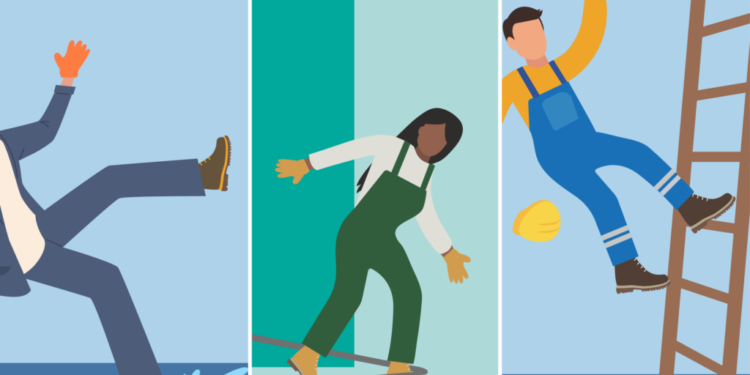Why Workplace Fall Prevention Is More Than Just Good Practice


Table of Contents
- 1 Key Takeaways
- 2 Table of Contents
- 3 The Real Risks: Why Falls Still Happen At Work
- 4 Latest Statistics On Workplace Falls
- 5 Proven Practices And Tools For Reducing Falls
- 6 Engineering Controls And Safety Systems
- 7 Training And Culture: The Human Side Of Safety
- 8 Recent Trends In Fall Prevention
- 9 Case Examples: Successful Fall Reduction In Action
- 10 Looking Ahead: The Future Of Workplace Fall Prevention
Key Takeaways
- Falls are one of the most frequent causes of workplace injuries across multiple industries and have a profound human and economic cost.
- Comprehensive fall prevention is built from quality equipment, engineering solutions, practical training, and a genuine culture of safety.
- Utilizing proven physical safety barriers can reduce the risk of falls in elevated workspaces.
- Adapting to recent trends, technological innovation, and learning from real-life stories helps organizations empower their workforce and minimize accident rates.
Table of Contents
- The Real Risks: Why Falls Still Happen At Work
- Latest Statistics On Workplace Falls
- Proven Practices And Tools For Reducing Falls
- Engineering Controls And Safety Systems
- Training And Culture: The Human Side Of Safety
- Recent Trends In Fall Prevention
- Case Examples: Successful Fall Reduction In Action
- Looking Ahead: The Future Of Workplace Fall Prevention
The Real Risks: Why Falls Still Happen At Work
Despite strengthened workplace regulations and awareness campaigns, falls remain widespread in various industries—from construction and warehousing to retail and manufacturing. Underlying risk factors are often layered: high employee turnover leads to gaps in safety knowledge, complex site layouts introduce new hazards, and routine activities sometimes breed complacency. Some fall dangers are hidden, emerging only as work processes or inventory layouts change. For instance, employees accessing mezzanine levels or elevated storage spaces may momentarily let down their guard, especially under tight deadlines.
Installing physical barriers like mezzanine safety netting addresses accidental slips and drops of tools or products, protecting individuals working below. These netting systems add an unobtrusive layer of protection and work best as part of a broader risk management plan. While no single solution eliminates all hazards, integrating structural safeguards helps create consistent, reliable safety standards that protect workers on both sides of a mezzanine or elevated platform.
Latest Statistics On Workplace Falls
Reviewing the data makes the issue impossible to ignore. According to the Occupational Safety and Health Administration, falls are the leading cause of death in the construction sector, year after year. But falls don’t just harm construction workers. The Bureau of Labor Statistics estimates that in 2021, more than 800 fatal work injuries in the United States resulted from falls, slips, or trips. These incidents are not only life-altering—they are often preventable.
In addition, nonfatal injuries from falls force millions of workdays to be lost each year, costing U.S. employers billions in lost productivity, medical expenses, and workers’ compensation. Such statistics are sobering reminders that even one overlooked hazard can have widespread consequences, impacting not just the individual but their team, their organization, and their community.
Proven Practices And Tools For Reducing Falls
A proactive approach is essential. Effective fall prevention isn’t simply about purchasing safety gear—it’s about weaving safety principles into every aspect of operations. Regular, diligent workplace inspections help reveal trip hazards and potential areas where employees could lose their footing. This process should be collaborative, encouraging employees to voice concerns and suggestions.
- Routine Inspections: Involve cross-departmental teams in regular site walk-throughs. Many hazards can hide in plain sight until an outsider points them out.
- Housekeeping: Assign responsibility for clearing clutter and cleaning spilled liquids or debris. Designated staff can rotate, ensuring vigilance becomes part of the daily routine.
- Physical Safety Barriers: Well-placed guardrails and mezzanine safety netting provide essential protection, especially where open edges or elevated platforms are used.
- Personal Protective Equipment: Equip workers with non-slip shoes, harnesses, and hard hats, and ensure these items are accessible and maintained regularly.
- Visual Reminders: Deploy warning stripes, caution signs, and proper lighting wherever floor elevation changes or where objects may fall.
Combining these practices has a synergistic effect, reducing immediate risk and signaling to workers that leadership values their safety. This fosters higher morale and a shared commitment to workplace well-being.
Engineering Controls And Safety Systems
Engineering controls mark a substantial advancement in minimizing workplace risks, especially when procedural solutions alone aren’t enough. Physical barriers—like anti-slip flooring in high-traffic corridors or scaffold netting around elevated work zones—help keep employees separated from potential hazards. For example, mezzanine safety netting offers adaptable protection that evolves with shifting layouts or operations, providing lasting safety even as workflows change.
Research supports the effectiveness of these controls. The Centers for Disease Control and Prevention notes that integrating layered barriers such as netting, guardrails, and audible alert systems can reduce fall-related accidents by nearly 50%. In addition, the growing accessibility of real-time monitoring tools—like sensors and smart cameras—allows supervisors to address risks before they escalate proactively. Far from being just a compliance measure, engineering controls like scaffold netting offer long-term value. They boost employee morale and retention by creating a visibly safer work environment and often pay for themselves by preventing costly injuries and operational disruptions.
Training And Culture: The Human Side Of Safety
No engineering solution is foolproof without skilled and safety-conscious people behind it. Advanced safety programs focus on relatable, real-world scenarios rather than theoretical lectures and prioritize hands-on, repeatable exercises. Frequent, bite-sized training updates help cement safety habits and keep policies fresh in the minds of new and seasoned employees.
Organizational employees’ minds are open to dialogue and see extraordinary returns. Encouraging every worker to report hazards or near misses—without fear of repercussions—helps management address minor issues before they become major incidents. Setting aside time to celebrate safety milestones, like months without lost workdays, creates a sense of collective achievement and pride. Safety becomes less about ticking boxes and more about building a genuine culture of care, embedded from onboarding to daily department briefings.
Recent Trends In Fall Prevention
As technology transforms other industries, it’s also reshaping how organizations approach fall safety. Wearable tech can now monitor an employee’s movements and fatigue, sending alerts if someone enters a restricted zone or appears unsteady. Digital reporting apps allow for immediate notification and documentation of hazards, giving supervisors real-time data to prioritize interventions. Moreover, companies are exploring AI-driven video analytics that recognize risky patterns—like improper lifting or climbing behaviors—and provide timely training reminders, replacing tried-and-true equipment, but instead complement it. Companies that combine physical protections like mezzanine safety netting with innovative technologies have an edge. They react faster and identify and anticipate future risks, keeping safety strategies agile and data-informed as workplaces change and grow.
Case Examples: Successful Fall Reduction In Action
It’s easy to quote statistics, but stories from the field resonate even more strongly. One national distributor facing repeated near misses on an elevated picking platform retrofitted their facility with high-visibility netting and an app-based hazard alert system. Within a year, reported fall-related incidents dropped sharply—a win for team morale and the budget.
- Another example is a manufacturer that restructured its floor plan to minimize worker travel across exposed elevated surfaces and used edge netting in its new setup. After implementation, OSHA recordable injuries from falls decreased by more than half.
- At a municipal utility, leadership implemented quarterly safety “town halls,” where employees shared experiences and recognized colleagues who reported hazards promptly. The result: not only did fall incidents dip, but engagement with all other safety topics also surged.
These experiences show that investments in prevention—whether structural, cultural, or both—can yield rewarding results in reduced injuries and a stronger workplace community.
Looking Ahead: The Future Of Workplace Fall Prevention
The future of fall prevention will be built on flexibility, data, and culture. As organizations adopt smart devices, advanced netting solutions, and refined training, they’ll catch emerging hazards earlier and eliminate them more efficiently. Leadership must stay vigilant, regularly audit systems, and solicit employee feedback to ensure programs remain relevant and practical.
For those willing to learn from real successes and embrace evolving best practices, the result will be safer environments, healthier staff, and organizations set to thrive in a changing world. Keeping fall prevention at the heart of workplace strategy isn’t just about following the rules—it’s about protecting the lives and livelihoods that power every business daily.






